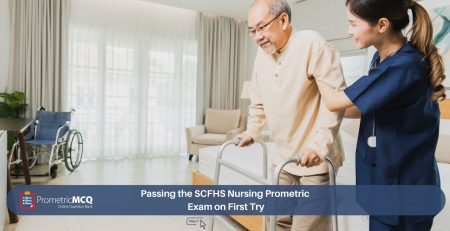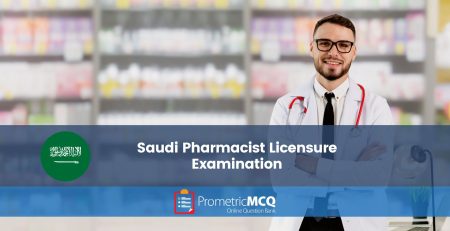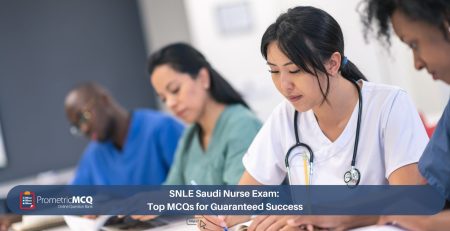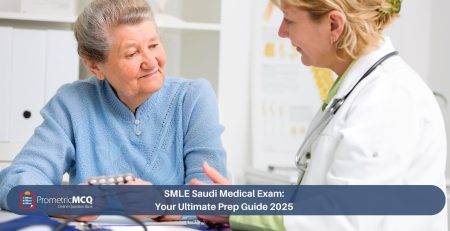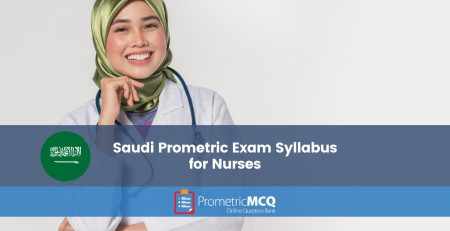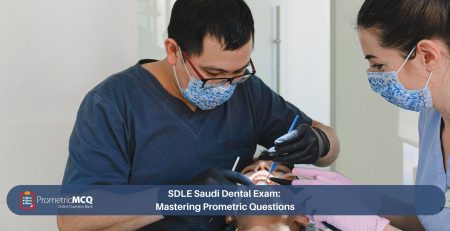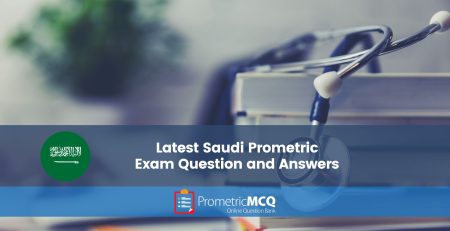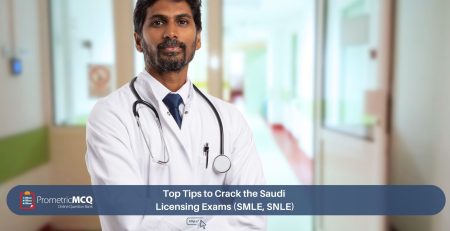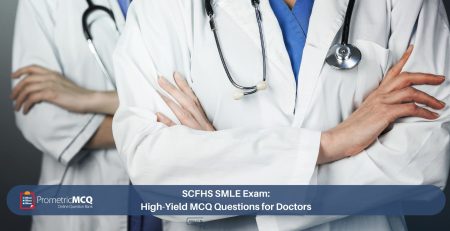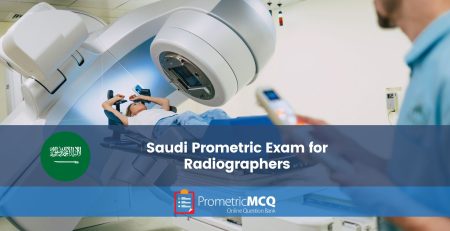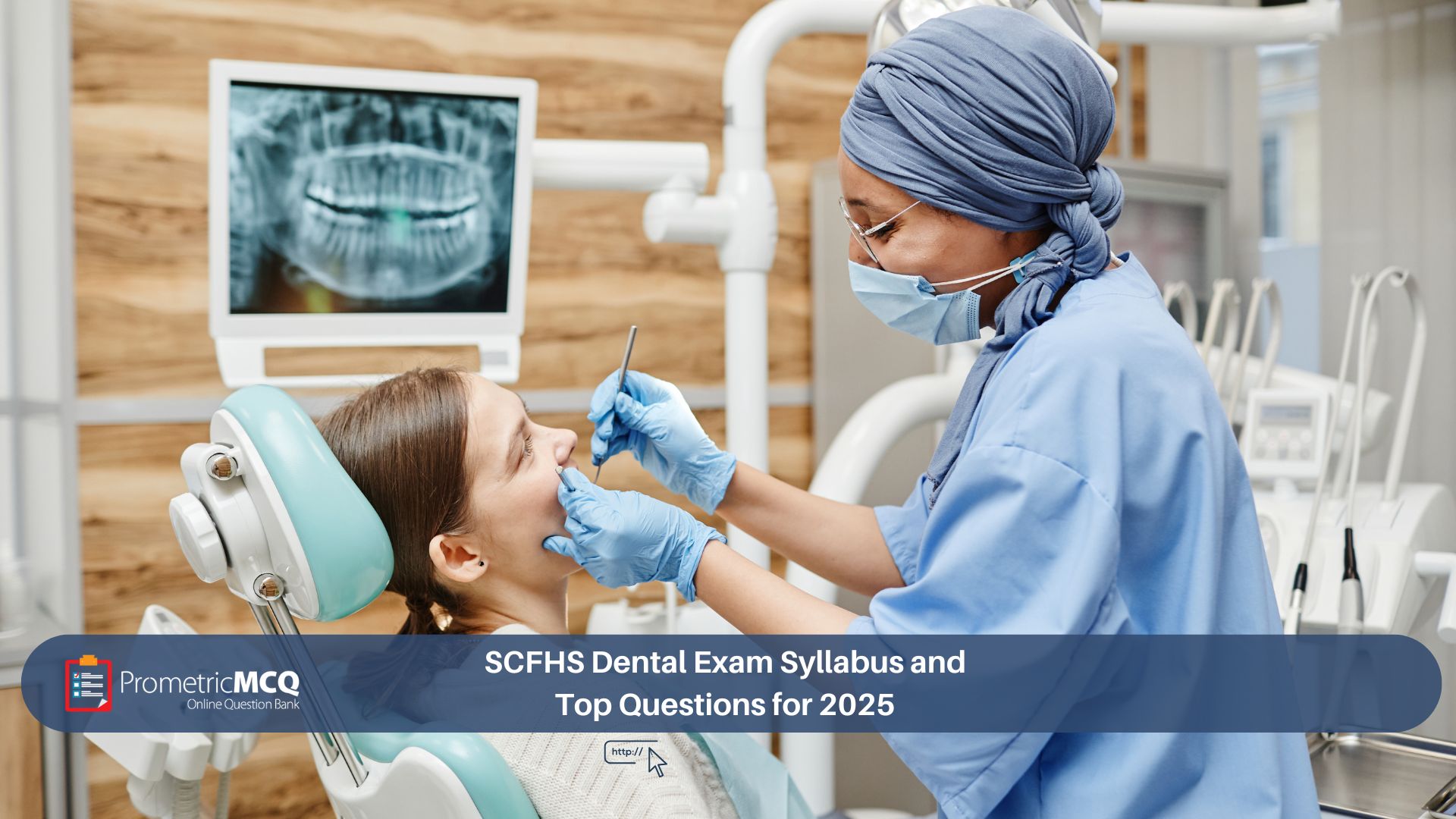
SCFHS Dental Exam Syllabus and Top Questions for 2025
fatima@prometricmcq.com2025-09-17T15:16:40+00:00Table of Contents
ToggleSCFHS Dental Exam Syllabus and Top Questions for 2025
For dental professionals seeking to practice in the Kingdom of Saudi Arabia, the Saudi Dental Licensing Exam (SDLE), administered by the Saudi Commission for Health Specialties (SCFHS), is the definitive gateway. This comprehensive Prometric exam is not just a test of theoretical knowledge; it is a rigorous evaluation of your clinical judgment, diagnostic acumen, and ability to formulate safe and effective treatment plans. A deep understanding of the official exam syllabus is the first and most crucial step toward success.
Many highly skilled dentists falter on the SDLE not due to a lack of knowledge, but due to a misaligned preparation strategy. Simply rereading textbooks is not enough. The key to passing is to master the high-yield topics within the syllabus and to relentlessly practice applying that knowledge to the case-based Multiple-Choice Questions (MCQs) that define the exam. Knowing what to study is as important as knowing how to study.
This ultimate 2025 guide provides a meticulous breakdown of the SCFHS dental exam syllabus, highlighting the most frequently tested concepts in each domain. Furthermore, we will present a series of top-tier sample questions with in-depth rationales, designed to give you a true feel for the exam’s complexity and style. This is your blueprint for an intelligent and effective study plan, starting with a broad overview of the Saudi Prometric exam for dentists.
Key Takeaways for SDLE Success
- Syllabus is Your Roadmap: Base your entire study plan on the official SCFHS dental exam blueprint, focusing on high-yield areas.
- Diagnosis & Treatment Planning are Core: The majority of questions will be clinical vignettes requiring you to diagnose a condition and select the most appropriate treatment.
- Radiographic Interpretation is Crucial: Be prepared to analyze various radiographs (periapical, bitewing, OPG) to identify pathology and anatomical structures.
- Master the Basics: A strong foundation in Operative Dentistry, Endodontics, and Oral Surgery will account for a significant portion of your score.
- Practice is Paramount: The single most effective study method is to answer and review thousands of high-quality, exam-style MCQs.
Deconstructing the 2025 SCFHS Dental Exam Syllabus (SDLE Blueprint)
The SDLE for general dentists is designed to be a comprehensive assessment. A successful candidate must demonstrate competency across all major fields of dentistry. Below is a detailed breakdown of the syllabus, highlighting the key topics you must master.
1. Operative Dentistry & Endodontics
This is a foundational and heavily weighted domain. It covers the core of “bread and butter” dentistry.
- Cariology: Modern concepts of caries management (e.g., ICDAS), risk assessment, and preventive strategies (fluorides, sealants).
- Cavity Preparation: G.V. Black’s classifications and their modern modifications for adhesive restorations.
- Dental Materials: In-depth knowledge of amalgam, resin composites (chemistry, properties, bonding generations), glass ionomers, and dental ceramics.
- Pulpal and Periapical Diagnosis: Differentiating between reversible pulpitis, irreversible pulpitis, and necrosis based on clinical and radiographic findings.
- Root Canal Treatment: Principles of access cavity preparation, cleaning and shaping (instrumentation techniques), irrigation, and obturation.
- Traumatic Dental Injuries: Classification and management of tooth fractures, luxations, and avulsions according to IADT guidelines.
2. Prosthodontics (Fixed and Removable)
This domain tests your ability to restore function and aesthetics for partially and fully edentulous patients.
- Treatment Planning: Principles of diagnosis and treatment planning for complex restorative cases.
- Fixed Prosthodontics: Principles of tooth preparation for various crown types (e.g., PFM, all-ceramic), impression materials and techniques, pontic design, and cementation protocols.
- Removable Prosthodontics: Design principles for removable partial dentures (RPDs), and clinical/laboratory steps for complete dentures (from impressions to insertion and post-insertion care).
- Dental Implants: Basic principles of implantology, including case selection, understanding of components, and restorative options. You will find more questions in our Implant Dentistry MCQs bank.
3. Oral Surgery, Oral Medicine, and Radiology
This broad domain covers everything from extractions to the diagnosis of complex oral lesions.
- Local Anesthesia: Pharmacology of local anesthetics and vasoconstrictors, injection techniques (e.g., IANB, Gow-Gates), and management of complications (e.g., syncope, hematoma, nerve injury).
- Extractions: Principles of simple and surgical extractions, management of impacted teeth (especially third molars), and post-operative care.
- Medical Emergencies: Recognition and initial management of common medical emergencies in the dental office, including anaphylaxis, hypoglycemia, and angina.
- Oral Medicine & Pathology: Diagnosis and management of common oral mucosal lesions (e.g., aphthous ulcers, lichen planus, candidiasis) and salivary gland disorders.
- Radiology: Principles of radiographic interpretation. You must be able to identify common pathologies (caries, cysts, tumors), anatomical landmarks, and technical errors on periapical, bitewing, and panoramic radiographs.
4. Periodontics
Focuses on the health of the supporting structures of the teeth.
- Diagnosis and Classification: Understanding the 2017 AAP classification of periodontal and peri-implant diseases.
- Etiology: The role of plaque biofilm and host response in periodontal disease.
- Non-Surgical Therapy: Principles and techniques of scaling and root planing.
- Surgical Therapy: Indications for procedures like gingivectomy, flap surgery, and bone grafting.
- Perio-Systemic Link: Understanding the relationship between periodontal disease and conditions like diabetes and cardiovascular disease.
Top SCFHS Dental Exam (SDLE) Sample Questions
The best way to conquer the syllabus is to practice applying your knowledge. The following sample questions reflect the style and difficulty of the real SDLE. For a comprehensive experience, practicing with dedicated SDLE questions is essential.
Question 1: Oral Surgery & Anesthesia
A 65-year-old male patient with a history of hypertension (controlled with Lisinopril) and a single coronary stent placed 2 years ago requires extraction of a grossly decayed mandibular first molar. He takes 81 mg of aspirin daily. What is the most appropriate management regarding his aspirin therapy?
- Stop the aspirin for 7 days before the extraction.
- Continue the aspirin therapy without alteration and use local hemostatic measures.
- Consult his cardiologist to switch him to heparin before the procedure.
- Halve the aspirin dose to 40 mg for 3 days prior to the extraction.
Correct Answer: B
Rationale: Current international guidelines overwhelmingly support the continuation of low-dose aspirin therapy for minor oral surgical procedures like a single tooth extraction. The risk of a major adverse cardiovascular event (like a stroke or MI) from stopping aspirin far outweighs the risk of post-operative bleeding, which can be easily controlled with local measures (e.g., sutures, absorbable gelatin sponge, tranexamic acid mouthwash). Stopping aspirin is no longer the standard of care.
Why other options are incorrect:
A: This is an outdated practice and is now considered dangerous as it significantly increases the patient’s thromboembolic risk.
C: Bridging with heparin is a complex process reserved for patients on potent anticoagulants like warfarin and is completely unnecessary for a patient on low-dose aspirin undergoing a minor procedure.
D: Altering the prescribed dose of a medication without consulting the prescribing physician is outside the scope of dental practice and offers no clinical benefit.
Question 2: Endodontics
A 25-year-old patient presents with severe, spontaneous throbbing pain in the maxillary right first premolar. The pain wakes him up at night and is exacerbated by hot stimuli, with cold providing temporary relief. A pulp vitality test with an electric pulp tester gives no response. A periapical radiograph shows a deep distal carious lesion but no periapical radiolucency. What is the most likely diagnosis?
- Reversible Pulpitis
- Symptomatic Irreversible Pulpitis with Symptomatic Apical Periodontitis
- Pulp Necrosis with Asymptomatic Apical Periodontitis
- Symptomatic Irreversible Pulpitis
Correct Answer: D
Rationale: The clinical picture is classic for symptomatic irreversible pulpitis. The key features are: spontaneous, severe pain; pain that lingers or is exacerbated by heat; and pain that may wake the patient from sleep. The temporary relief with cold is also a common finding. While the electric pulp test (EPT) result of “no response” might suggest necrosis, the overwhelming clinical symptoms of severe pain point to a vital but severely inflamed pulp. The absence of periapical radiolucency and lack of pain on percussion (not mentioned, but implied by the options) means there is not yet apical periodontitis.
Why other options are incorrect:
A: Reversible pulpitis involves sharp pain to a stimulus (like cold or sweet) that resolves immediately upon removal of the stimulus. It is never spontaneous or severe.
B: This diagnosis would be correct if the patient also had severe pain on biting or percussion, indicating inflammation has spread to the periapical tissues.
C: Pulp necrosis is the death of the pulp. It is typically asymptomatic (unless an abscess forms) and would not present with severe, spontaneous pain.
Frequently Asked Questions (FAQs) for the SCFHS Dental Exam
The SCFHS does not publish an official passing percentage. The exam is graded as Pass/Fail based on a predetermined competency standard. However, the widely accepted benchmark among candidates is to aim for a score of 60-65%. To be safe, your goal in practice tests should be to consistently score above 70%.
The SDLE is a highly clinical exam focused on the competencies of a general dentist. While the core dental knowledge is universal, the SDLE may have a stronger emphasis on common clinical presentations and management. Unlike the INBDE, which is integrated and has a heavy clinical judgment component, the SDLE is a more direct test of knowledge across distinct dental specialties.
The general dentist (SDLE) exam typically consists of 200 multiple-choice questions, which are to be completed in two separate sessions of two hours each (100 questions per session) on the same day. This gives you an average of 1.2 minutes per question.
Unlike the pharmacy exam, the dental exam focuses almost exclusively on universal clinical and scientific knowledge. While you are expected to adhere to international ethical standards, you are unlikely to be asked about specific administrative laws of the Saudi Ministry of Health.
Focus on gold-standard, internationally recognized textbooks. Key recommendations include: Sturdevant’s Art and Science of Operative Dentistry, Cohen’s Pathways of the Pulp for Endodontics, Contemporary Oral and Maxillofacial Surgery by Hupp, and Carranza’s Clinical Periodontology.
It is a mandatory and critical step. The DataFlow Group verifies your educational degrees, licenses, and experience letters directly from the source. This process runs in parallel with your exam preparation. It’s crucial to ensure all your documents are accurate and your previous institutions are responsive. For more details, review the SCFHS DataFlow process.
Candidates are usually allowed a total of three attempts to pass the SDLE. There is typically a waiting period required between attempts. After three unsuccessful attempts, a candidate may be required to undergo a period of additional training before being eligible to re-apply. Always check the latest official regulations from SCFHS.
While a good QBank will have many radiographic questions, supplementing with a dedicated atlas like White and Pharoah’s “Oral Radiology: Principles and Interpretation” is highly beneficial. Practice identifying everything from common caries and bone loss to more complex cysts and tumors.
Clinical practice guidelines from major international bodies are the basis for many questions. Familiarity with recommendations from the American Dental Association (ADA), the International Association of Dental Traumatology (IADT), and the American Academy of Periodontology (AAP) will be extremely helpful.
After passing the exam and completing the DataFlow verification, you will be classified as a “Registered” professional with the SCFHS. You can then use this to secure a job. Once you have a job offer, your employer will assist you in activating your professional license, allowing you to legally practice dentistry in the Kingdom. This final step leads to your official SCFHS license.
Conclusion: Your Strategic Path to SDLE Success
The SCFHS Dental Licensing Exam is a comprehensive test of your ability to practice dentistry safely and effectively. A deep, strategic understanding of the exam syllabus is the foundation upon which a successful preparation campaign is built. Use this guide to focus your studies on the high-yield topics, and commit to a rigorous regimen of MCQ practice to hone your clinical reasoning skills. This disciplined, syllabus-driven approach is your most reliable strategy for passing the SDLE and beginning a rewarding dental career in Saudi Arabia.
You've Studied the Syllabus. Now Conquer the Exam.
Move beyond theory and into application. Our premium QBank for the Saudi Dental Licensing Exam is filled with thousands of high-yield questions, detailed rationales, and simulated tests to guarantee you are fully prepared.

